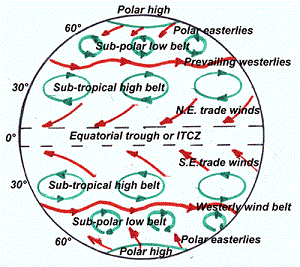The Key Difference Between "Westerly Wave" and "Continental Air" lies in their nature and origin:
1. Westerly Waves (Upper Air Westerlies)
Definition: These are large-scale **troughs and ridges* in the mid-latitude *jet stream* (upper-level winds) that move from west to east.
Formation: Caused by **Rossby waves* (planetary waves) due to Earth's rotation and temperature contrasts.
Impact: They influence **weather systems*, bringing cyclones, rain, and storms.
Location: Found in the **upper troposphere* (mid-latitudes).
2. Continental Air Mass
Definition: A **dry and cold* air mass that forms over large land areas (e.g., Siberia, Canada).
Formation: Develops due to **lack of moisture* and intense cooling over continents.
Impact: Brings **cold, dry weather* in winter (e.g., cold waves in North India).
Location: Forms near the **surface* (not upper air like westerly waves).
Key Differences
Feature Westerly Waves Continental Air
Type Upper-air wind pattern Surface air mass
Movement West to East Depends on pressure systems
Moisture Can bring rain (if interacting with moisture) Dry
Temperature Varies (depends on wave phase) Cold (in winter)
Formation Due to jet stream dynamics Due to land cooling
Summary
*Westerly waves* are *upper-air wind patterns* that steer weather systems.
*Continental air* is a *surface-level dry and cold air mass* originating over land.


 Irfan Rashid
Irfan Rashid
0 comments